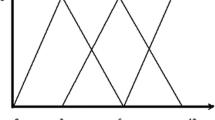Abstract
Machine-learning and data-mining techniques have been developed to turn data into useful task-oriented knowledge. Most algorithms for mining association rules identify relationships among transactions using binary values and find rules at a single-concept level. Transactions with quantitative values and items with hierarchical relationships are, however, commonly seen in real-world applications. This paper proposes a fuzzy multiple-level mining algorithm for extracting knowledge implicit in transactions stored as quantitative values. The proposed algorithm adopts a top-down progressively deepening approach to finding large itemsets. It integrates fuzzy-set concepts, data-mining technologies and multiple-level taxonomy to find fuzzy association rules from transaction data sets. Each item uses only the linguistic term with the maximum cardinality in later mining processes, thus making the number of fuzzy regions to be processed the same as the number of original items. The algorithm therefore focuses on the most important linguistic terms for reduced time complexity.
Similar content being viewed by others
References
R.S. Michalski, I. Bratko, and M. Kubat, Machine Learning and Data Mining: Methods and Applications, John Wiley & Sons, 1998.
R. Agrawal, T. Imielinksi, and A. Swami, “Mining associations between sets of items in massive databases,” in The 1993 ACM SIGMOD Conference on Management of Data, Washington DC, USA, 1993, pp. 207–216.
R. Agrawal, T. Imielinksi, and A. Swami, “Database mining: A performance perspective,” IEEE Transactions on Knowledge and Data Engineering, vol. 5, no.6, pp. 914–925, 1993.
M.S. Chen, J. Han, and P.S. Yu, “Data mining: An overview from a database perspective,” IEEE Transactions on Knowledge and Data Engineering, vol. 8, no.6, pp. 866–883, 1996.
A. Famili, W.M. Shen, R. Weber, and E. Simoudis, “Data preprocessing and intelligent data analysis,” Intelligent Data Analysis, vol. 1, no.1, pp. 3–23, 1997.
W.J. Frawley, G. Piatetsky-Shapiro, and C.J. Matheus, “Knowledge discovery in databases: An overview,” in The AAAI Workshop on Knowledge Discovery in Databases, Anaheim, CA, 1991, pp. 1–27.
T. Fukuda, Y. Morimoto, S. Morishita, and T. Tokuyama, “Mining optimized association rules for numeric attributes,” in The Fifteenth ACMSIGACT-SIGMOD-SIGART Symposium on Principles of Database Systems, Montreal, Canada, 1996, pp. 182–191.
J. Han and Y. Fu, “Discovery of multiple-level association rules from large databases,” in The International Conference on Very Large Databases, Zurich, Switzerland, 1995, pp. 420–431.
T.P. Hong, C.S. Kuo, and S.C. Chi, “A data mining algorithm for transaction data with quantitative values,” Intelligent Data Analysis, vol. 3, no.5, pp. 363–376, 1999.
R. Srikant, Q. Vu, and R. Agrawal, “Mining association rules with item constraints,” in The Third International Conference on Knowledge Discovery in Databases and Data Mining, Newport Beach, CA, August 1997, pp. 67–73.
R. Srikant and R. Agrawal, “Mining quantitative association rules in large relational tables,” in The 1996 ACM SIGMOD International Conference on Management of Data, Monreal, Canada, June 1996, pp. 1–12.
R.L.P. Chang and T. Pavlidis, “Fuzzy decision tree algorithms,” IEEE Transactions on Systems, Man and Cybernetics, vol. 7, no.1, pp. 28–35, 1977.
R. Rastogi and K. Shim, “Mining optimized association rules with categorical and numeric attributes,” in The 14th IEEE International Conference on Data Engineering, Orlando, 1998, pp. 503–512.
R. Rastogi and K. Shim, “Mining optimized support rules for numeric attributes,” in The 15th IEEE International Conference on Data Engineering, Sydney, Australia, 1999, pp. 206–215.
A. Kandel, Fuzzy Expert Systems, CRC Press: Boca Raton, FL, pp 8–19, 1992.
A.F. Blishun, “Fuzzy learning models in expert systems,” Fuzzy Sets and Systems, vol. 22, no.1, pp. 57–70, 1987.
L.M. de Campos and S. Moral, “Learning rules for a fuzzy inference model,” Fuzzy Sets and Systems, vol. 59, no.2, pp. 247–257, 1993.
M. Delgado and A. Gonzalez, “An inductive learning procedure to identify fuzzy systems,” Fuzzy Sets and Systems, vol. 55, no.2, pp. 121–132, 1993.
A. Gonzalez, “A learning methodology in uncertain and imprecise environments,” International Journal of Intelligent Systems, vol. 10, no.3, pp. 357–371, 1995.
T.P. Hong and J.B. Chen, “Finding relevant attributes and membership functions,” Fuzzy Sets and Systems, vol. 103, no.3, pp. 389–404, 1999.
T.P. Hong and J.B. Chen, ”Processing individual fuzzy attributes for fuzzy rule induction,” Fuzzy Sets and Systems, vol. 112, no.1, pp. 127–140, 2000.
T.P. Hong and C.Y. Lee, “Induction of fuzzy rules and membership functions from training examples,” Fuzzy Sets and Systems, vol. 84, no.1, pp. 33–47, 1996.
J. Rives, “FID3: Fuzzy induction decision tree,” in The First International Symposium on Uncertainty, Modeling and Analysis, University of Maryland: College Park, MD, pp. 457–462, 1990
C.H. Wang, T.P. Hong, and S.S. Tseng, “Inductive learning from fuzzy examples,” in The Fifth IEEE International Conference on Fuzzy Systems, New Orleans, 1996, pp. 13–18.
C.H. Wang, J.F. Liu, T.P. Hong, and S.S. Tseng, “A fuzzy inductive learning strategy for modular rules,” Fuzzy Sets and Systems, vol. 103, no.1, pp. 91–105, 1999.
C. Clair, C. Liu, and N. Pissinou, “Attribute weighting: A method of applying domain knowledge in the decision tree process,” in The Seventh International Conference on Information and Knowledge Management, Bethesda, Maryland, USA, 1998, pp. 259–266.
J.R. Quinlan, “Decision tree as probabilistic classifier,” in The Fourth International Machine Learning Workshop, Morgan Kaufmann: San Mateo, CA, pp. 31–37, 1987.
J.R. Quinlan, C4.5: Programs for Machine Learning, Morgan Kaufmann: San Mateo, CA, 1993.
R. Weber, “Fuzzy-ID3: A class of methods for automatic knowledge acquisition,” in The Second International Conference on Fuzzy Logic and Neural Networks, Iizuka, Japan, 1992, pp. 265–268.
Y. Yuan and M.J. Shaw, “Induction of fuzzy decision trees,” Fuzzy Sets and Systems, vol. 69, no.2, pp. 125–139, 1995.
T.P. Hong, C.S. Kuo, and S.C. Chi, “Trade-off between time complexity and number of rules for fuzzy mining from quantitative data,” International Journal of Uncertainty, Fuzziness, and Knowledge-Based Systems, vol. 9, no.5, pp. 587–604, 2001.
L.A. Zadeh, “Fuzzy sets,” Information and Control, vol. 8, no.3, pp. 338–353, 1965.
Author information
Authors and Affiliations
Rights and permissions
About this article
Cite this article
Hong, TP., Lin, KY. & Chien, BC. Mining Fuzzy Multiple-Level Association Rules from Quantitative Data. Applied Intelligence 18, 79–90 (2003). https://doi.org/10.1023/A:1020991105855
Issue Date:
DOI: https://doi.org/10.1023/A:1020991105855




